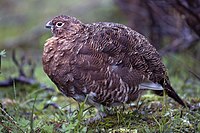
Photo from wikipedia
Understanding demographic mechanisms is key to managing animal populations, both in conservation and game management. We examine which life-stages contributed most to population growth in a recovering red grouse Lagopus… Click to show full abstract
Understanding demographic mechanisms is key to managing animal populations, both in conservation and game management. We examine which life-stages contributed most to population growth in a recovering red grouse Lagopus lagopus scotica population following restoration of management aimed at resuming economically viable harvesting. Demographic parameters derived from biannual grouse counts and from radio-tagged individuals were analysed using ‘standard demographic accounting’. When parameter estimates were based on counts, a combination of adult summer and winter survival appeared to contribute most to population change. When based on radio-tagged birds, deemed more reliable because of independence between parameters and years, adult summer survival and chick survival contributed most to population change. The contributions of clutch size, nesting success (i.e. the proportion of nests with ≥1 egg hatching) and hatching success (proportion of eggs hatching in successful nests) were negligible. Overall, the survival rate of adults and chicks contributed most to annual population change and reduced the rate of population recovery. Analysis of grouse carcasses found that 82% were associated with signs of predation or scavenging by raptors. Rates of juvenile production exceeded those of adult mortality, allowing modest population growth, but insufficient to resume economically viable harvesting.
Journal Title: Wildlife Biology
Year Published: 2018
Link to full text (if available)
Share on Social Media: Sign Up to like & get
recommendations!